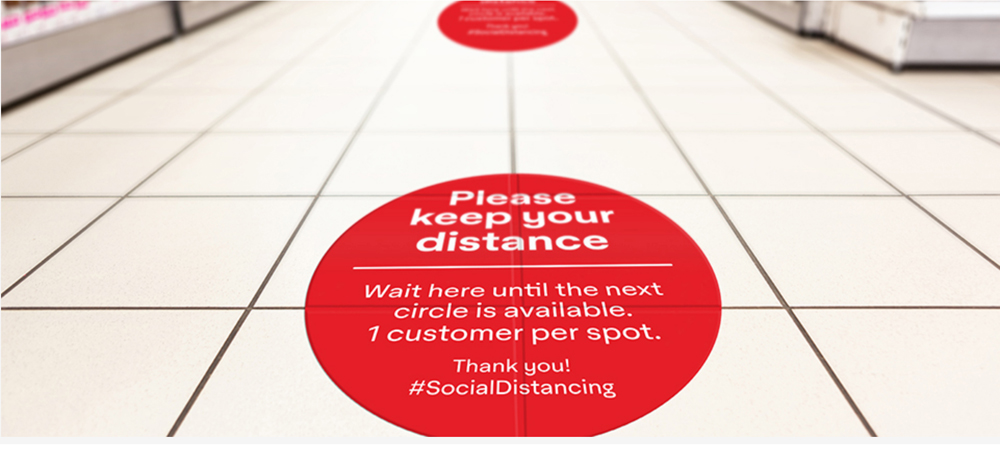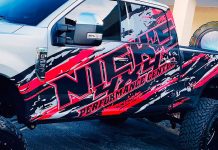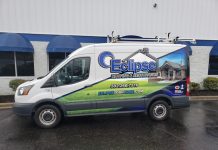 As brands try to catch a consumer’s attention in every possible location and direction, floor graphics are becoming increasingly popular and causing many of us to look down and take notice. Creative designers and installers are incorporating floor graphics for high-traffic retail environments, healthcare and community spaces, and also for P-O-P, special events, and home and office decoration. Designers also have the opportunity to take creativity to a whole new level with 3D floor graphics. Once the designer creates a concept for the kind of floor graphic they want and the overall effect of the design, the next step is determining which pressure sensitive vinyl to use.
As brands try to catch a consumer’s attention in every possible location and direction, floor graphics are becoming increasingly popular and causing many of us to look down and take notice. Creative designers and installers are incorporating floor graphics for high-traffic retail environments, healthcare and community spaces, and also for P-O-P, special events, and home and office decoration. Designers also have the opportunity to take creativity to a whole new level with 3D floor graphics. Once the designer creates a concept for the kind of floor graphic they want and the overall effect of the design, the next step is determining which pressure sensitive vinyl to use.
Before choosing a vinyl, the designer and installer should ask a series of questions with the customer to choose the best solution for their needs.
These questions include:
- Is the graphic going to be indoors or outside?
- Will foot traffic or vehicle traffic come in contact with the graphic?
- What kind of substrate will the graphic adhere to?
- Is the substrate smooth or textured
- How long is the graphic expected to last?
Once you gather these details you are now ready to choose the film for your application. Here are some helpful tips and products from Avery Dennison that you can choose to use for a successful floor graphic:
Smooth Flat Substrates (Indoors) are usually the easiest to install and to choose a film for application. Examples of smooth substrates include sanded/finished wood floors (basketball courts), linoleum floors, painted and sanded concrete or marble.
Grocery stores or department stores will utilize floor graphics for wayfinding or promotional graphics. With the current precautions in place due to COVID-19 we are required to change our group interactions at these places. To help with the six-foot suggested spatial distance, stores are placing graphics on their floors to indicate where each customer should stand and wait, while in the check-out line.
Typically a calendered film that is 3- to 4-mil thick with removable adhesive or permanent adhesive is ideal for these types of applications. Avery Dennison recommends using MPI 2902 gloss removable or MPI 2903 gloss permanent films for digitally printable films that will be used indoors.
If you’re looking for the quickest and easiest material to install we recommend using Avery Dennison MPI 2903 Easy Apply™ or MPI 2921 Easy Apply™. The Easy Apply™ technology will allow for easy removal of air bubbles and will speed up your installation time.
You will want to make sure to protect floor graphics with a UL classified slip resistant overlaminate. The Avery Dennison DOL 2000 and DOL 3000 series overlaminates are available in three finishes, gloss, luster and matte and are UL certified for use on floor graphics.
Rough or Textured Substrates (Indoors) can be a little more difficult to install. Examples include ceramic tile floors or indoor painted concrete.
These types of substrates will usually require a cast vinyl to conform with the peaks and valleys of the texture. Sometimes a heat source will be needed, which will soften the film during install and allow it to conform more easily. For this type of installation Avery Dennison recommends using MPI 1105 Easy Apply RS™ as a digitally printable film option. This film will conform very nicely creating a paint-like finish on the floor. When using an Avery Dennison cast film, make sure you use an overlaminate to protect the graphic. The Avery Dennison DOL 1060, would be recommended for graphic protection and UL certified for slip resistance.
One final unique application growing in popularity is installing short term graphics on low pile carpet in hotels, conference centers and trade shows. For these types of installs, Avery Dennison recommends using a permanent adhesive calendered film. Since the application is going to be short-term, typically for a weekend trade-show or event, there’s no need to use a high performance cast vinyl. Carpet textures can be difficult to adhere to so using a permanent adhesive film will help achieve the highest rate of success.
To read more, click here.
—Joey Heiob, Technical Specialist, Avery Dennison Graphics Solutions











